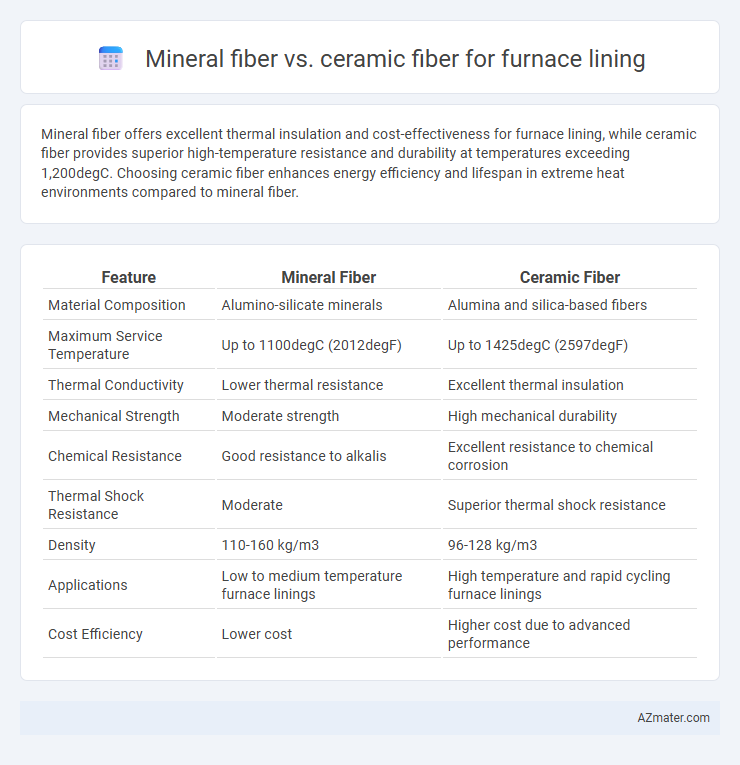Mineral fiber offers excellent thermal insulation and cost-effectiveness for furnace lining, while ceramic fiber provides superior high-temperature resistance and durability at temperatures exceeding 1,200degC. Choosing ceramic fiber enhances energy efficiency and lifespan in extreme heat environments compared to mineral fiber.
Table of Comparison
| Feature | Mineral Fiber | Ceramic Fiber |
|---|---|---|
| Material Composition | Alumino-silicate minerals | Alumina and silica-based fibers |
| Maximum Service Temperature | Up to 1100degC (2012degF) | Up to 1425degC (2597degF) |
| Thermal Conductivity | Lower thermal resistance | Excellent thermal insulation |
| Mechanical Strength | Moderate strength | High mechanical durability |
| Chemical Resistance | Good resistance to alkalis | Excellent resistance to chemical corrosion |
| Thermal Shock Resistance | Moderate | Superior thermal shock resistance |
| Density | 110-160 kg/m3 | 96-128 kg/m3 |
| Applications | Low to medium temperature furnace linings | High temperature and rapid cycling furnace linings |
| Cost Efficiency | Lower cost | Higher cost due to advanced performance |
Introduction to Furnace Lining Materials
Mineral fiber and ceramic fiber are widely used furnace lining materials due to their excellent thermal insulation and resistance to high temperatures. Mineral fibers, made from natural or synthetic minerals, offer good thermal shock resistance and are cost-effective for moderate temperature applications up to 1200degC. Ceramic fibers, composed primarily of alumina and silica, provide superior thermal stability, low thermal conductivity, and can withstand temperatures exceeding 1400degC, making them ideal for advanced furnace linings requiring high durability and energy efficiency.
What is Mineral Fiber?
Mineral fiber, also known as mineral wool, is a man-made insulation material produced from natural rocks like basalt or diabase, melted and spun into fibers resembling wool. It offers excellent thermal insulation, soundproofing, and fire resistance, making it suitable for furnace lining applications. Compared to ceramic fiber, mineral fiber is generally more environmentally friendly, less brittle, and better at handling thermal shock.
What is Ceramic Fiber?
Ceramic fiber is an advanced refractory material composed primarily of alumina and silica, used for furnace lining due to its excellent thermal insulation and resistance to high temperatures exceeding 1,260degC (2,300degF). Unlike mineral fiber, ceramic fiber offers superior chemical stability, low thermal conductivity, and high tensile strength, making it ideal for industrial furnaces, kilns, and boilers. Its lightweight and flexible nature also contributes to easier installation and improved energy efficiency in high-temperature applications.
Thermal Insulation Properties
Mineral fiber offers excellent thermal insulation with a maximum service temperature around 1200degC, making it suitable for medium-temperature furnace linings. Ceramic fiber provides superior thermal insulation, operating efficiently up to 1430degC, enabling better energy conservation in high-temperature furnace environments. Both materials have low thermal conductivity, but ceramic fiber's higher melting point and thermal shock resistance make it preferred for demanding high-heat applications.
Temperature Resistance Comparison
Mineral fiber offers temperature resistance typically up to 1100degC, making it suitable for moderate-temperature furnace linings. Ceramic fiber excels with higher temperature resistance, often withstanding temperatures above 1400degC, ideal for high-temperature industrial furnaces. The superior thermal stability of ceramic fiber ensures enhanced durability and insulation efficiency under extreme heat conditions compared to mineral fiber.
Durability and Longevity
Mineral fiber offers excellent thermal insulation but tends to degrade faster under high-temperature cycling compared to ceramic fiber, which is engineered for superior durability and longevity in furnace linings. Ceramic fiber provides enhanced resistance to thermal shock, chemical corrosion, and mechanical wear, extending the operational lifespan of furnace linings significantly. This makes ceramic fiber the preferred choice for applications requiring sustained high-temperature exposure and minimal maintenance.
Installation and Handling Differences
Mineral fiber offers easier installation for furnace lining due to its lighter weight and greater flexibility, reducing labor time and physical strain during handling. Ceramic fiber, while more rigid and heavier, requires careful handling with protective gear to prevent skin irritation and respiratory issues caused by its denser, fibrous composition. The installation of mineral fiber is faster and less cumbersome, whereas ceramic fiber's robustness demands more meticulous positioning and securing to maintain the furnace's thermal efficiency.
Cost Analysis: Mineral vs Ceramic Fiber
Mineral fiber offers a lower initial cost compared to ceramic fiber, making it an economical choice for furnace lining in applications with moderate temperature requirements. Ceramic fiber, while more expensive upfront, provides superior thermal insulation and longer lifespan at high temperatures, reducing replacement frequency and maintenance costs over time. Considering total life cycle expenses, ceramic fiber often delivers better cost efficiency in high-temperature industrial environments due to its durability and energy-saving properties.
Safety and Environmental Considerations
Mineral fiber and ceramic fiber differ significantly in safety and environmental impact when used for furnace lining. Mineral fiber, made from natural or synthetic materials like basalt or slag, tends to have lower bio-persistence and releases fewer respirable fibers, reducing health risks during installation and maintenance. Ceramic fiber, composed primarily of alumina and silica, offers superior high-temperature resistance but can pose greater respiratory hazards due to its bio-persistent fibers and generates more waste requiring careful disposal to minimize environmental harm.
Choosing the Right Fiber for Furnace Lining
Mineral fiber offers excellent thermal insulation and is cost-effective for moderate-temperature furnace linings, while ceramic fiber withstands higher temperatures and provides superior resistance to thermal shock and chemical corrosion. Choosing the right fiber depends on the furnace's operating temperature, thermal cycling frequency, and exposure to harsh chemicals. For high-temperature applications above 1200degC and frequent thermal cycling, ceramic fiber is preferred, whereas mineral fiber suits lower temperature ranges below 1000degC with less aggressive conditions.

Infographic: Mineral fiber vs Ceramic fiber for Furnace lining
 azmater.com
azmater.com